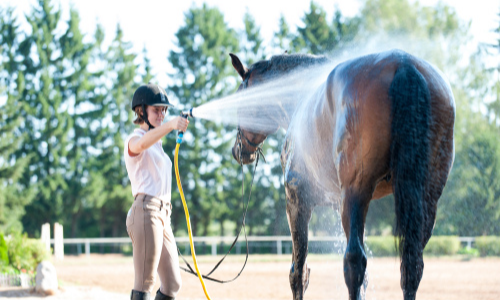Caring For Your Horse in Hot Weather
- Created in Newsletter Library, Equine

10 Hot Weather Horse Care Tips
Heat and humidity can be just as uncomfortable for your horse as it is for you. When the mercury rises, your equine's risk of dehydration, sunburn, and heatstroke increases. Luckily, you can keep your horse cool and comfortable by following a few of these tips.
1. Offer Shade
Ample shade is a must for horses that spend long hours outdoors during the summer. Pastures with mature trees or run-in sheds offer shady places for your horses to gather when the sun becomes too intense.
2. Provide Plenty of Fresh Water
Many horses avoid drinking water if it's stagnant or warm. Unfortunately, it doesn't take long for cool water to become warm on a hot day. The less water your horse drinks, the greater the chance of dehydration. If you don't have an automatic watering system, change the water in buckets and troughs several times a day.
3. Replace Salt Blocks Often
Some horses need a little encouragement to drink on scorching hot days. When salt blocks are placed close to buckets and waterers, your horses' water intake is likely to increase.
4. Limit Activity on Extremely Hot, Humid Days
Long rides or strenuous work put your horses at risk of heatstroke when the temperature rises and the humidity level is high. The University of Minnesota Extension recommends not riding your horses when the combined air temperature and relative humidity exceeds 150. (For example, an air temperature of 90 degrees Fahrenheit combined with a relative humidity of 80 percent would equal 170.)
When that figure rises above 150, it's much harder for your horses to sweat. Sweating offers a natural cooling effect that keeps your horses from overheating.
5. Use Hoses or Misters to Keep Your Horse Cool
Hose your horses with cool water or use misters to improve comfort on hot, humid days. After hosing your horses, immediately scrape away excess water.
6. Give Your Horses Haircuts
Long coats trap heat. Clipping your horse's coat will improve airflow and allow sweat to evaporate easily. Avoid clipping the coat too short to reduce the risk of sunburn.
7. Make Sure Stables offer Adequate Ventilation
Good ventilation is the key to keeping your stable comfortable during hot summer days. Multiple openings in sidewalls and ridges keep air flowing and prevent the air from becoming stale. If fresh air enters through the door, but there's nowhere for stale air to exit, your stable will become uncomfortably hot.
According to the Penn State Extension, there should be less than a 10-degree difference between outside and inside air temperature if a stable is properly ventilated.
8. Prevent Sunburn
Horses can suffer from sunburn too. Most at risk for sunburn are horses that:
- Are Completely White or Have White Patches
- Have Bald Spots
- Have Pink Noses or Muzzles
Paints, Pintos, and Appaloosas are among the breeds most likely to suffer from sunburn, according to an article in The Horse. Sunscreen can be helpful, although it must be reapplied throughout the day. Fly sheets or full-face fly masks that offer protection from ultraviolet (UV) light can also be helpful.
9. Change Your Turnout Schedule
Keeping your horses inside during the middle of the day can improve their comfort and help them avoid sunburn and heatstroke. On particularly hot days, turning them out early in the morning or after the sun begins to go down can be the safest option.
10. Learn the Signs of Heatstroke
Quick treatment is needed to protect your horse if it shows signs of heatstroke. Signs include:
- A Temperature of 105 Degrees Fahrenheit or Higher
- Rapid Breathing
- Stumbling
- Rapid Pulse
- Disinterest in Food, Water or Exercise
- Warm Skin
- Excessive Sweating
- Weakness
- Dehydration (Sunken eyes or skin that doesn't quickly bounce back if you pinch it lightly)
If your horse exhibits any of these signs, move it to a cool, shady place. Follow cooling recommendations offered by the American Association of Equine Practitioners and apply ice to the major blood vessels. These include the jugular veins on both sides of the neck and the veins on the insides of the back and front legs.
Offer your horse small amounts of water and electrolytes. Call your equine veterinarian if your horse's symptoms don't improve quickly. In severe cases, heatstroke can cause seizures and death.
Do you have questions about keeping your horses safe and healthy this summer? Contact our office and we'll be glad to make a few recommendations or pay a visit to your horses.
Sources:
The Horse: Sunburn and Photo Sensitivity in Horses, 8/1/10
Penn State Extension: Horse Stable Ventilation
University of Minnesota Extension: Caring for Horses During Hot Weather
National Animal Supplement Council: Hot Weather Horse: Summer Tips for Proper Horse Care, 8/9/16


